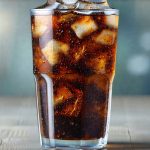Urinalysis is a remarkably common diagnostic tool used in healthcare. From routine check-ups to investigating specific symptoms, analyzing urine provides valuable insights into overall health, kidney function, and potential underlying conditions. It’s often one of the first lines of investigation when a doctor suspects something isn’t quite right, offering clues about everything from hydration levels and dietary habits to infections and metabolic disorders. Because urinalysis is so frequently employed, patients naturally wonder how everyday lifestyle factors – like diet – might influence its results. Specifically, there’s considerable curiosity surrounding whether consuming diet soda impacts the findings of a urine test.
The concern arises because diet sodas contain artificial sweeteners and various additives that aren’t present in natural bodily fluids. These components could theoretically show up as abnormal readings during urinalysis, leading to misinterpretations or unnecessary follow-up tests. However, the relationship isn’t always straightforward. The effects of diet soda on a urinalysis can be nuanced, dependent on several factors including the type of sweetener used, individual metabolic rates, and the specific parameters being measured in the test. This article will delve into these complexities, exploring how diet soda might interact with common urinalysis components and offering guidance for patients undergoing testing.
Diet Soda Composition and Urinalysis Parameters
Diet sodas aren’t simply water with artificial sweeteners; they are complex concoctions designed to mimic the taste of sugar-sweetened beverages. The primary difference lies in the sweetener, typically one or more of these: aspartame, sucralose, saccharin, acesulfame potassium (Ace-K), or stevia. Each of these has a different metabolic pathway and excretion route within the body. Urinalysis generally assesses several key parameters including specific gravity, pH, protein levels, glucose, ketones, bilirubin, urobilinogen, nitrites, leukocyte esterase, and microscopic examination for cells and crystals. The potential for diet soda to influence these varies considerably.
For example, artificial sweeteners are generally excreted largely unchanged through the kidneys, meaning they can be detected in urine. While not typically flagged as abnormal on a standard urinalysis report, their presence could theoretically interfere with certain automated testing methods used in some labs. More significantly, the additives and colorings within diet soda can impact the appearance of the urine sample itself, potentially influencing microscopic examination results. The acidity levels of these drinks can also shift the pH of the urine temporarily, which is a parameter routinely measured during analysis.
The impact isn’t always negative. In some cases, the increased fluid intake from consuming diet soda might simply dilute the urine, lowering specific gravity and making it harder to detect low levels of other substances. This dilution effect isn’t unique to diet soda – any significant fluid consumption before a test can have similar results. However, the added chemical components present in diet soda introduce additional layers of complexity that aren’t present with plain water intake. It is crucial to remember that urinalysis provides a snapshot in time, and recent dietary choices can influence the findings. Understanding how sugar intake affects kidney health is also relevant when considering overall dietary impact.
Artificial Sweeteners and Renal Excretion
The way our bodies process artificial sweeteners significantly impacts their potential to alter urinalysis results. Aspartame, for instance, breaks down into phenylalanine, formaldehyde, and methanol during digestion. While these metabolites are usually processed and eliminated efficiently by a healthy liver, individuals with impaired liver function might experience an accumulation of these substances, potentially leading to detectable levels in urine. Sucralose is also largely excreted unchanged, meaning it can be detected, but its impact on other parameters is generally minimal.
Saccharin has been shown to have some renal effects even at low doses, and while not necessarily causing significant abnormalities in a standard urinalysis, it’s worth considering when interpreting results. Acesulfame potassium (Ace-K) similarly undergoes limited metabolism, leading to substantial excretion via the kidneys. Stevia-based sweeteners are generally considered less likely to interfere with urinalysis as they are largely metabolized by gut bacteria and have minimal renal excretion of intact compounds.
Ultimately, the amount of artificial sweetener consumed before a test plays a role. A single can of diet soda is unlikely to cause significant interference for most individuals with normal kidney function. However, consistent high intake could potentially affect results. – It’s important to note that the sensitivity of different urinalysis testing methods varies between labs. – Some newer, more sophisticated methods may be less susceptible to interference from these compounds than older techniques. To further understand potential impacts on kidney health, it’s helpful to review how aging affects kidney stone risk.
pH Levels and Urinalysis Accuracy
The pH level of urine is a critical parameter assessed during urinalysis, providing insights into kidney function and metabolic processes. A normal pH range typically falls between 4.6 and 8.0. Diet sodas are generally acidic due to the presence of phosphoric acid and citric acid used for flavoring and preservation. Consuming diet soda shortly before a urine test can temporarily lower the urinary pH, potentially skewing results.
A transient drop in pH isn’t always clinically significant, but it could influence the formation and detection of certain crystals during microscopic examination. For example, uric acid crystals are more likely to form in acidic urine. A falsely low pH reading could lead to an inaccurate assessment of kidney stone risk or metabolic imbalances. Furthermore, changes in pH can affect the stability of other components being measured in the urinalysis, such as proteins and bilirubin.
To minimize this effect, it’s generally recommended to avoid consuming highly acidic beverages like diet soda for several hours before undergoing a urine test. – Drinking water is always the best option for hydration prior to testing. – If you have consumed diet soda shortly before your test, inform your healthcare provider so they can take this into account when interpreting the results. Consider also that overhydration affects urinalysis outcomes too.
Microscopic Examination Interference
Urinalysis routinely includes microscopic examination of urine sediment – looking for cells (red blood cells, white blood cells), crystals, and casts. The additives and colorings in diet soda can potentially interfere with accurate microscopic identification. For example, certain artificial colors could be mistaken for red blood cells under a microscope, leading to a false positive result for hematuria (blood in the urine).
The high osmolality of some diet sodas – due to concentrated sweeteners and additives – may also influence crystal formation, making it more difficult to distinguish between normal and abnormal crystals. Similarly, the presence of particulate matter from the soda itself could be misinterpreted as cellular debris or casts. This is particularly relevant if a urine sample appears cloudy or discolored.
Accuracy in microscopic examination heavily relies on skilled technicians and proper laboratory protocols. A well-equipped lab will have procedures to minimize these potential interferences, such as using calibrated microscopes and employing experienced personnel. However, it’s still prudent to inform your healthcare provider about any recent diet soda consumption before undergoing urinalysis. This allows them to request a repeat test if necessary or consider other diagnostic methods to confirm the findings. It is also important to understand what does protein in urine mean on a urinalysis?, as this can be impacted by hydration.
It’s important to reiterate that this information is for general knowledge and informational purposes only, and does not constitute medical advice. Always consult with a qualified healthcare professional for any health concerns or before making any decisions related to your health or treatment. For more comprehensive kidney health guidance, explore resources on how diet affects the formation of kidney stones.





















